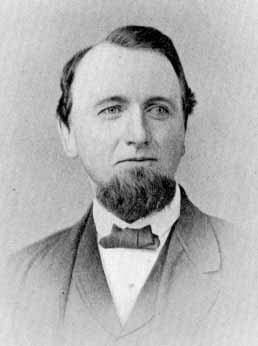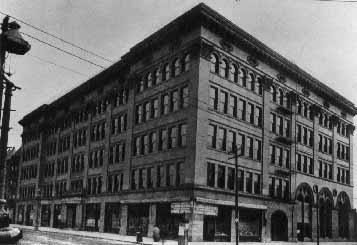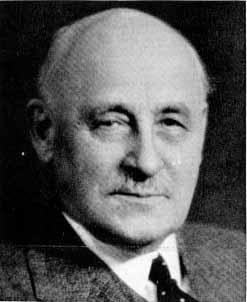The following is a condensed form of an essay written after 1940 by Agness J. Kaufman, who served as the Registrar of Lewis Institute for more than 20 years. She also served as the secretary to the school's director, George Noble Carman. Ms. Kaufman was a graduate of the University of Chicago with a degree in education. This essay was addressed to "Mr. Editor" and perhaps was authored for one of the early publications of Illinois Institute of Technology shortly after the 1940 merger of Lewis Institute and Armour Institute of Technology.

Lewis Institute came into existence though the will of a citizen of Chicago, Allen Cleveland Lewis, who left his estate in trust for that purpose. Allen was born in Sterling, Connecticut in 1821 and died in Chicago in 1877. As a young man he resided in Elgin, Illinois, where he was engaged in the drug business. He married and had one son who died at the age of twenty months. His wife did not long survive, and Mr. Lewis moved to Chicago.
In 1874, three years before his death, his older brother, John, died and left Mr. Lewis an estate of some $350,000, the larger part of which was invested in railroad bonds. Little is known of how Allen C. acquired the added share of the $550,000 estate he left. He also acquired several large pieces of property which evidently were [transferred to] him by another brother, Henry. This real estate was of dubious value at the time of his death, but fifty years later some pieces brought "tidy sums."
The Lewis will was probated in 1877 with an order in it to the effect that the estate must increase to at least $800,000 before a school was opened. And so, in 1895, the "trustees decided the time had come" to open Lewis Institute. In those years the estate had increased from $550,000 to $1,600,000. The record of these first trustees is certainly admirable.
Just a word as to the choice for the site for the new school. Our trustees of that time - John A. Roche, Christian C. Kohlsaat, and John McLaren - purchased lots at the southeast corner of Madison and Robey streets (now Damen Avenue). Articles of incorporations were granted to them, and the will of Allen C. Lewis, visioned far ahead of the times in educational thought, became the charter of the new Institute.

All of the pieces of property mentioned before were on car-line streets in accordance with a statement that "as much of the building as consistent should be devoted to general business purposes, so as to get as great an income therefrom as possible." So the first floor of the building consisted of stores, four of which in later years, were rented to the Chicago Public Library to carry out an expressed provision that a "free reading room was to be provided for the public," our own school library having proved inadequate in size. Aside from the space to be devoted to general business purposes, the will provided for the setting up of lecture halls, study rooms, and the free reading room mentioned before, which was to be supplied with newspapers and magazines of the day, and while the standard works on art and literature were to be furnished, "novels and sensational literature were to be avoided."
The will provided for the maintenance of an evening school "with courses of a kind and character not generally taught in the public schools of the city, and with special branches or studies that would be directly useful to students in obtaining a position and occupation for life." There were evening schools, in the eastern cities at least, before this will was probated, but educators point out that the above quoted paragraph is probably the first actual provision made for adult education in the sense we know it today. In addition a "school for respectable females" was to be maintained in the different branches of art, science, design, etc., instruction in which might enable them to gain a livelihood there from. Even in the 1870's it was evident to a far-seeing planner that men were not always going to be able to support their families and that women would have to work.
Another paragraph in the will provided for the "establishment and maintenance of a Polytechnic School, second to none, though, in no way, was this school to interfere with the school for females."
With the instructions of the will at hand, and the building started, the trustees set about to determine the nature, scope, and management of the Institute about to open its doors. Our files contain very interesting and remarkable letters from educators, prominent Chicagoans, and again from John Q. Public as to what should be taught in the new school. Fortunately the trustees had the intelligence to turn for help to the newcomer in out city whose modern ideas in education were startling the Middle West - William Rainey Harper.

Dr. Harper, who had been somewhat handicapped in the experiments he would like to have tried at the University of Chicago, eagerly seized the opportunity to develop some of his new ideas under more favorable circumstances. From the younger men working with him at the time, he recommended George Noble Carman, then Principal of Morgan Park Academy and a member of the English department of the University of Chicago, to head the new institution. These two men agreed perfectly as to the plan of study to be carried on, the trustees acquiesced, and Lewis Institute was incorporated to offer a four-year high school course in technical subjects and liberal arts, and an additional two years of college work in arts and engineering. While the actual term "junior college" is not used in this specific grant, Lewis really became the first junior college to be established in the United States. In that first year, 1896-97, a day, evening, and a summer session were conducted, and if newspaper publicity is an indication of educational value to public, Lewis certainly filled a long felt need. One of the first of the experimental schools was on its way, and no one was even hired on the faculty who was not willing to "go along" with new ideas in education.
On the memorable morning that the Director and the Dean came up Madison street actually to open the doors of the Institute, two little boys were sitting on the curb-stone waiting for the great event. Both of them are now well known in the educational world; one of them, the mathematical wonder George Birkhoff, was said by many to have been the greatest mathematician in the world at the time of his death. I should not be so rash as to say that the actual training George received during his high school and college years at Lewis made him what he was, but he always insisted that the encouragement he received there to step out of the beaten paths and to develop his own mathematical ideas started him on his way.
The Institute, in those days, instead of offering formal examinations to new students, held an "opening week," a classification period such as we know today. I have never heard of the plan being used before it was tried out here, but it may have been in existence elsewhere. The problem of the individual was always strongly stressed, for the Institute began by establishing an "elective" system in the high school years in the hope of developing self expression. The three "R's" and the classical background were emphasized, but the student had a chance to choose a few subjects to complete his program and was delighted with his liberty, while the die-hards in the city schools shook their heads in horror at the departure from the cut and dried formulas of the day. Many years later, at a banquet of honor given to Director Carman, much was said as to the time and thought he had given to the development of the individual, and the original Dean of the Institute, Professor Edwin H. Lewis, whose writings were generally so profound that only a few could understand them, penned these line "To Our Chief":
Carman likes to make a man, and now you'll agree
He did his level best to make a man of you and me.
Carman likes 'em different, and, too, we'll all agree
I ain't no copy of you, my dear, you ain't no copy of me.
For one by one he studied us, he studied you and me,
And always he respected individuality.
A great expert in persons and a maker of them, too -
That's what the dear old boy has been to all he ever knew.
In the second year of its existence the Institute was host to a group of men from all over this western section of the country. Led by Dr. Harper, with Director Carman and Dean Greeson of the Institute, and Dr. Angell of Michigan, these man were working on establishing standards in building and equipment, and the group were anxious to study new physical developments as well as to work on standards, so they filled our Auditorium, and at those meetings the accrediting association known as the North Central Association of High Schools and Colleges was formed. Lewis always occupied a place on its list.
In 1901 the trustees began granting degrees to mechanical engineers and, in the years that followed, this department was extended to include other fields of engineering. In 1903 the building on Damen avenue was erected to increase the facilities of the engineering department. John A. Roche, former Mayor of Chicago and the first President of our Board of Trustees, who was devoted to the interests of Lewis, promoted the undertaking.
Home economics courses were opened with the Institute, and since this was a comparatively new field in this section for the country, they grew rapidly in attendance until, with the demand for college graduates as home economics teachers, the Institute took a step forward and granted that degree to its students. That was in 1912. This department ran the lunchroom in those early days, another novel feature found in no other high school in Chicago.
Some few years ago the Home Economics section of the Bureau of Education at Washington, studying the history of this department, found that the course generally known as "Household Management" or later as "The House; Its Plan, Selection, and Care" was first evolved and taught at Lewis in the early 1900s.
The opening paragraph in the section of the Lewis will that pertains to the founding of the Institute says "It has long been my desire to, in some manner, provide for and assist those in need of an education, and who are so circumstanced in life as to be unable without aid and assistance to obtain the instruction and gain access to books and papers of art and science that their future advancement in life requires." At the time the Institute opened it was not possible to comply with this desire, because so few of "those so circumstanced" cared to have more formal education than was offered in the grade schools, and inasmuch as Lewis was built in the heart of what was then one of the fashionable and well-to-do districts in the city, it started its career with the easily acquired title of a "fashionable preschool." This situation existed until as late as 1908, when another general shift in population took place, and was unable financially to attend one of the larger universities. Then, at last, the fundamental desire of the founder came to be realized.
In 1909, through the generosity of LaVerne Noyes, one of our trustees, a co-operative course was inaugurated for boys of high school age who also served as apprentices in industry. The tuition of the boys was paid by Mr. Noyes when they were not working, and splendid co-operation was given to the course by many firms in the city. The decrease in the attendance of boys of high school age and the requirements of industry during the early years of World War I made it necessary to close the co-operative course.
In 1913 a contract was signed with the Portland Cement Association to establish the Structural Materials Laboratory at the Institute for purposes of research and for the training of men competent to assist in concrete construction. This laboratory was maintained until 1926 when the Association moved into its own building.
During World War I, Lewis was the headquarters of the educational work of the Sixth Corps Area. A most successful training school for ground mechanics was maintained there, and rehabilitation work for veterans was carried on for about six years after the war. Letters in our files that came to Director Carman from the War Department in Washington indicate that the plan inaugurated at Lewis served as a model in many colleges throughout the country.
In 1917, because of a growing demand for more college work, the general degree of Bachelor of Science was added to the Engineering and Home Economics degrees. Then the evening session courses were offered on the college level, the Academy was discontinued, and the Institute emerged from World War I as a four-year college on the lists of the North Central Association.
Probably the most outstanding feature of Lewis Institute was the administration under the leadership of Director Carman, who was generally acclaimed one of the leading educators of his day, and who remained at the helm for forty years. It was his custom to register and consult with each student personally in the day school, and with as many as he could in the evening school. He lived for the Institute, and after the death of his wife in 1916 he made it his day and night work, seven days a week and he had no other interests. It is said that he did the most outstanding piece of personnel work that has ever been accomplished in an American college. The tenure of the faculty who served under him was long, for the men and women who taught at Lewis believed in the purpose of the school and were willing to devote their lives to teaching at the Institute.
That the Institute served the purpose for which it was founded can scarcely be doubted. During the first ten years of its existence, the attendance in the day and evening sessions amounted to about 10,000 individuals. From that time on, as the desire for education grew among young people, the numbers mounted rapidly, and in 1940 more than 100,000 students had attended the Institute from one term to twenty years - a record made by a student in the evening session.
I cannot conclude without this observation - I have never known anyone who had a real and honorable part in this educational venture known as Lewis Institute, either as a student or as a member of the faculty or of the basement staff who did not gain something fine from the contact, or who did not contribute something in the way of loyalty or devotion that was beyond price.
Image Credits
Allan C. Lewis: 1903 Lewis Annual
The Lewis Institute: Irene Macauley, The Heritage of Illinois Institute of Technology (Chicago: Illinois Institute of Chicago, 1978)
George Noble Carman: 1933 Lewis Annual



